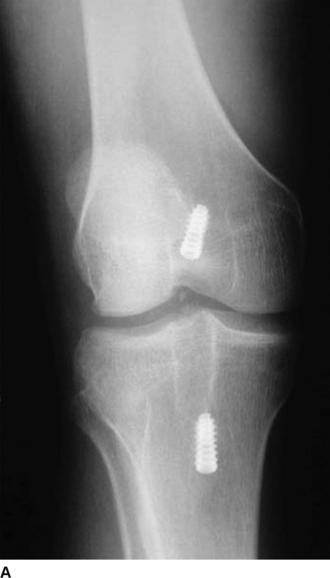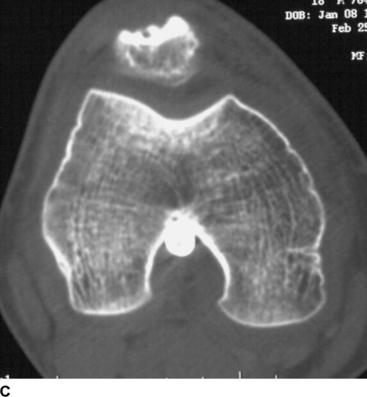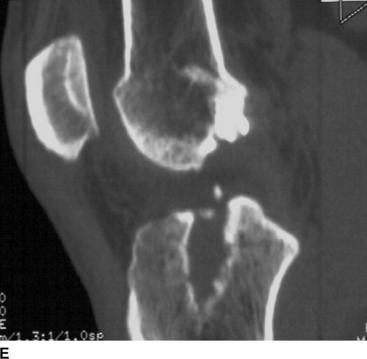Chapter 76 Hardware Complications After Anterior Cruciate Ligament Reconstruction
Interference Screws
Intraoperative complications include intraarticular placement of the hardware, which ideally will be recognized during the procedure and adjusted accordingly (Fig. 76-1). During insertion of the screw, possible complications include laceration of the graft-passing suture,1 advancement of the graft within the bone tunnel,1 graft laceration1 and even rupture,2 fracture of the graft bone plug,3 and screw breakage.4–6 To minimize the risk of lacerating the passing suture, at least one suture can be passed through the tendon at the base of the bone plug.1 To minimize the risk of graft rupture, methylene blue can be used to mark the bone–tendon junction of the graft, the anterior portion of the bone tunnel can be notched to ease the initial engagement of the screw, the cancellous edge of the bone plug can be placed facing anterior flush with the intraarticular edge of the femoral tunnel, and a protective sheath or cannula can be used to protect the graft during screw placement.2 Another helpful technique to protect the graft is to insert the femoral screw over a guidewire drilled through a cannulated screwdriver.
If the graft ruptures during screw placement, a number of salvage options may be used. If a patellar tendon graft is cut at the bone–tendon junction, the graft can be reversed, placing the intact bone plug in the femoral tunnel and fixing the tendinous portion of the graft through the tibial tunnel with a post or button.2,7 If the remaining graft length is insufficient, an alternative autograft or allograft should be used. To minimize the chance of graft advancement, it is important to maintain constant tension on the passing sutures during screw insertion.1 Screw breakage during insertion has been reported with bioabsorbable screws in as many as 10% of cases.4,5 Steps to minimize such a complication include use of a dilator device to create a pilot hole for screw insertion, maintenance of continuous pressure on the screwdriver to keep it fully seated, and use of a screw 1 mm smaller than the diameter of the tunnel.6
Postoperative complications include intraarticular placement of hardware, which may not be recognized at the time of surgery and can present clinically after the index procedure. A second procedure may be necessary to reposition or remove the misplaced hardware. Late screw breakage8–12 and delayed intraarticular migration of interference screws13–16 have also been described in the literature. Late migration of interference screws is rare but should be considered in the case of sudden pain in the late postoperative period after ACL reconstruction and, in the case of a metallic screw, can easily be evaluated with plain films. If such a complication is encountered, removal is mandated to minimize mechanical problems and cartilage damage.9,14,17 An arthroscopic approach is preferred,17 even if the screw is in the notch or popliteal fossa, although an arthrotomy may be required.15
Endobutton
The Endobutton is another widely used fixation device that has been associated with specific complications. The Endobutton may remain in the femoral tunnel rather than flipping outside of the tunnel to rest on the lateral femoral cortex18 (Fig. 76-2). Conversely, the Endobutton may be pulled too far off the femoral cortex into the overlying soft tissue19 (Fig. 76-3). To ensure that the Endobutton has flipped and is in the correct position, the femoral tunnel length should be overdrilled by 6 mm and the graft should be marked at a location 6 mm distal to the desired insertion level.18












